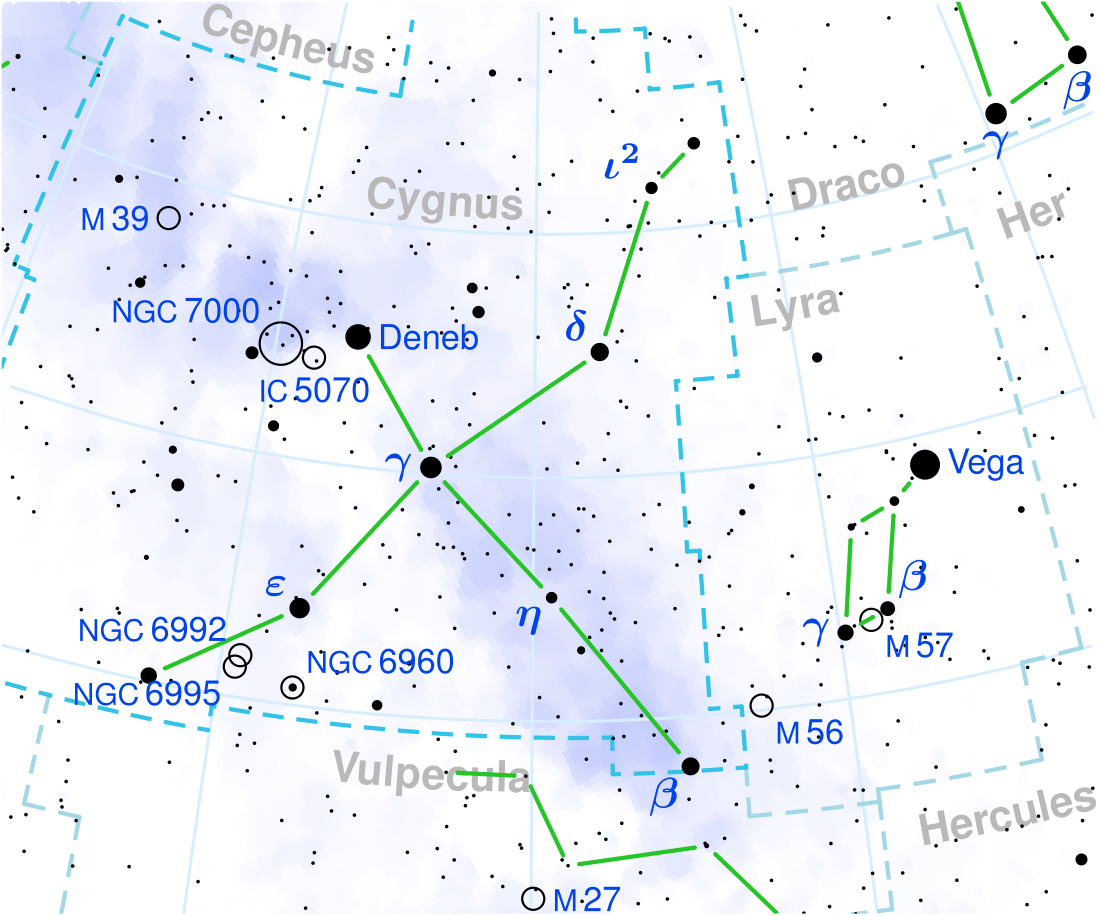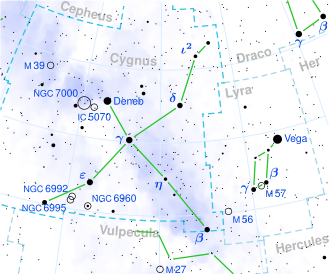Top Qs
Timeline
Chat
Perspective
Pi1 Cygni
Star in the constellation Cygnus From Wikipedia, the free encyclopedia
Remove ads
Pi1 Cygni, also named Azelfafage /əˈzɛlfəfeɪdʒ/, is a star in the northern constellation of Cygnus. It is visible to the naked eye, having a combined apparent visual magnitude of 4.66.[2] The distance to this system can be roughly gauged by its annual parallax shift of 1.89 mas,[1] which yields a separation of around 1,700 light years from the Sun, give or take a hundred light years.
Remove ads
Nomenclature
Summarize
Perspective
π1 Cygni (Latinised to Pi1 Cygni, abbreviated Pi1 Cyg, π1 Cyg) is the star's Bayer designation. The designations of the two components as Pi1 Cygni A and B derive from the convention used by the Washington Multiplicity Catalog (WMC) for multiple star systems, and adopted by the International Astronomical Union (IAU).[9]
It bore the traditional name Azelfafage, derived from the Arabic al-sulaḥfāh, the tortoise, originally a name for Lyra that was misattributed to a star in Cygnus.[10][11] R. H. Allen's 1899 book Star Names incorrectly[10] states that the name is derived from ظلف الفرس Dhilf al-faras meaning "the horse track" or (probably) ذيل الدجاجة Dhail al-dajājah meaning "the tail of the hen".[12] In 2016, the IAU organized a Working Group on Star Names (WGSN)[13] to catalogue and standardize proper names for stars. The WGSN approved the name Azelfafage for Pi1 Cygni on 12 September 2016 and it is now so included in the List of IAU-approved Star Names.[14]
In Chinese, 螣蛇 (Téng Shé), meaning Flying Serpent, refers to an asterism consisting of Pi1 Cygni, Alpha Lacertae, 4 Lacertae, Pi2 Cygni, HD 206267, Epsilon Cephei, Beta Lacertae, Sigma Cassiopeiae, Rho Cassiopeiae, Tau Cassiopeiae, AR Cassiopeiae, 9 Lacertae, 3 Andromedae, 7 Andromedae, 8 Andromedae, Lambda Andromedae, Kappa Andromedae, Psi Andromedae and Iota Andromedae. Consequently, the Chinese name for Pi1 Cygni itself is 螣蛇四 (Téng Shé sì, English: the Fourth Star of Flying Serpent).[15]
Remove ads
Properties
Pi1 Cygni has been described as a single-lined spectroscopic binary with a close, circular orbit, having a period of just 26.33 days.[16] However, a 2020 paper finds no radial velocity variations on the timescale of the published orbit.[17]
The primary, visible, star is a somewhat evolved B-type subgiant star with a stellar classification of B3 IV.[3] It has an estimated 10 times the mass of the Sun and around 5.6[18] times the Sun's radius. The star radiates 16,538[19] times the solar luminosity from its outer atmosphere at an effective temperature of roughly 18,360 K.[2] It is about 25[3] million years old and is spinning with a projected rotational velocity of 55 km/s.[7]
Remove ads
References
Wikiwand - on
Seamless Wikipedia browsing. On steroids.
Remove ads

